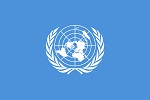Amercom ACBG70 Zil 131 General Purpose Truck - United Nations, 2001 (1:72 Scale)
"By powerful artillery fire, air strikes, and a wave of attacking tanks, we're supposed to swiftly crush the enemy."
- Marshal Georgi K. Zhukov
 The ZIL-131 is a general purpose 3.5 tons 6x6 army truck designed in the Soviet Union, the basic model being a general cargo truck. Variants include a tractor-trailer truck, a dump truck, a fuel truck, and a 6x6 for towing a 4-wheeled powered trailer. The ZIL-131 also serves as a platform for the 9P138 rocket launcher, a 30-tube variant of the BM-21 "Grad".
The ZIL-131 is a general purpose 3.5 tons 6x6 army truck designed in the Soviet Union, the basic model being a general cargo truck. Variants include a tractor-trailer truck, a dump truck, a fuel truck, and a 6x6 for towing a 4-wheeled powered trailer. The ZIL-131 also serves as a platform for the 9P138 rocket launcher, a 30-tube variant of the BM-21 "Grad".
The ZIL-131 is part of a family of two trucks sharing identical components by ZIL, which also included the ZIL-130. Both trucks were introduced in 1967. The ZIL-131 6x6 has the same equipment as the GAZ-66 and Ural-375D. Unlike the ZIL-131, the ZIL-130 is intended for civilian use.
The ZIL-130/131 is still in production at the "AMUR" truck plant (as the AMUR 531340), with both gasoline and diesel engines.
Pictured here is a 1:72 scale Russian-built Zil 131 general purpose truck used by the United Nations in 2001.
Now in stock!
Dimensions:
Length: 3-1/2-inches
Width: 1-1/2-inches
Release Date: April 2014
Historical Account: "UNBRO" - The United Nations Border Relief Operation (UNBRO) was a donor-nation funded relief effort for Cambodian refugees and others affected by years of warfare along the Thai-Cambodian border. It functioned from 1982 until 2001.
In January 1979, following the ouster of the Khmer Rouge from power by invading Vietnamese forces, hundreds of thousands of Cambodians sought food and shelter along the Thai-Cambodian border, triggering calls for international relief efforts. Initially a consortium of international agencies known as the "Joint Mission" and consisting of UNICEF, the ICRC, UNHCR, and the WFP took responsibility for food distribution, health care, camp construction and sanitation along with considerable support from the Royal Thai Government. However it soon became clear that humanitarian aid provided at camps such as Sa Kaeo would permit the Khmer Rouge to recover from their near-defeat at the hands of the Vietnamese, with a protracted civil war as the likely result. Because of this and ongoing conflicts with other aid agencies, ICRC and then UNICEF reduced their role in the management of refugee relief services on the border. UNHCR worked only with residents of holding centers such as Khao-I-Dang and Phanat Nikhom and provided no services in the border camps.
In January 1982, UNBRO was established to coordinate border relief operations under the direction of the Special Representative of the Secretary General of the United Nations for Coordination of Cambodian Humanitarian Assistance Programs (OSRSG), then headed by Sir Robert Jackson. Known originally as "WFP-UNBRO", its first director was the UNDP's Resident Coordinator in Bangkok, Winston R. Prattley, who also served as WFP representative. Because the operation had no staff at the beginning, UNICEF agreed to a six-month loan of its Kampuchean Emergency Unit until UNBRO could hire its own people.
UNBRO was a temporary agency, created by the UN General Assembly to address a specific crisis. It had a mandate but no charter or independent governing council. Nor did it have an independent budget; it had to rely on the support of donor countries from the General Assembly, solicited through pledges at donor meetings twice a year. UNBRO received its monetary and in-kind donations primarily from the United States, the European Commission, Japan, France, the United Kingdom, Australia and Canada.
Length: 3-1/2-inches
Width: 1-1/2-inches
|


